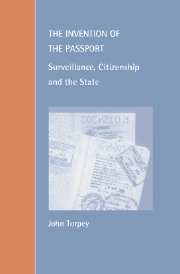Book contents
- Frontmatter
- Contents
- Acknowledgments
- Introduction
- 1 Coming and Going: On the State Monopolization of the Legitimate “Means of Movement”
- 2 “Argus of the Patrie”: The Passport Question in the French Revolution
- 3 Sweeping Out Augeas's Stable: The Nineteenth-Century Trend Toward Freedom of Movement
- 4 Toward the “Crustacean Type of Nation”: The Proliferation of Identification Documents From the Late Nineteenth Century to the First World War
- 5 From National to Postnational? Passports and Constraints on Movement from the Interwar to the Postwar Era
- Conclusion: A Typology of “Papers”
- Notes
- References
- Index
3 - Sweeping Out Augeas's Stable: The Nineteenth-Century Trend Toward Freedom of Movement
Published online by Cambridge University Press: 24 August 2009
- Frontmatter
- Contents
- Acknowledgments
- Introduction
- 1 Coming and Going: On the State Monopolization of the Legitimate “Means of Movement”
- 2 “Argus of the Patrie”: The Passport Question in the French Revolution
- 3 Sweeping Out Augeas's Stable: The Nineteenth-Century Trend Toward Freedom of Movement
- 4 Toward the “Crustacean Type of Nation”: The Proliferation of Identification Documents From the Late Nineteenth Century to the First World War
- 5 From National to Postnational? Passports and Constraints on Movement from the Interwar to the Postwar Era
- Conclusion: A Typology of “Papers”
- Notes
- References
- Index
Summary
The defeat of Napoleonic adventurism and the stabilization of European interstate relations following the Congress of Vienna (1815) soon led to a relaxation of the controls on movement that had gone into effect during the revolutionary conflagrations, or that had existed since long before they began. The century-long period of relative peace that followed constituted the framework for the dissolution of feudal ties where they still held sway, a process that in Prussia began during the Napoleonic wars and was in part a form of compensation to those elements of the male population drafted into military service during those conflicts. Clausewitz and other reformers realized that German society would have to be transformed in a more liberal and egalitarian direction if it were to be in a position to match the fighting ability that had been newly demonstrated by the French “nation in arms.” Liberation from traditional dues and obligations also gained impetus, of course, from the example set by the abolition of feudalism in France in August 1789. In short, keeping the peasants bound to the land as they had been since the so-called “manorial reaction” of the sixteenth century grew increasingly untenable in western Europe, though the East remained as yet little affected by this trend.
This newly won freedom was deeply troubling to the guardians of social order.
- Type
- Chapter
- Information
- The Invention of the PassportSurveillance, Citizenship and the State, pp. 57 - 92Publisher: Cambridge University PressPrint publication year: 1999



